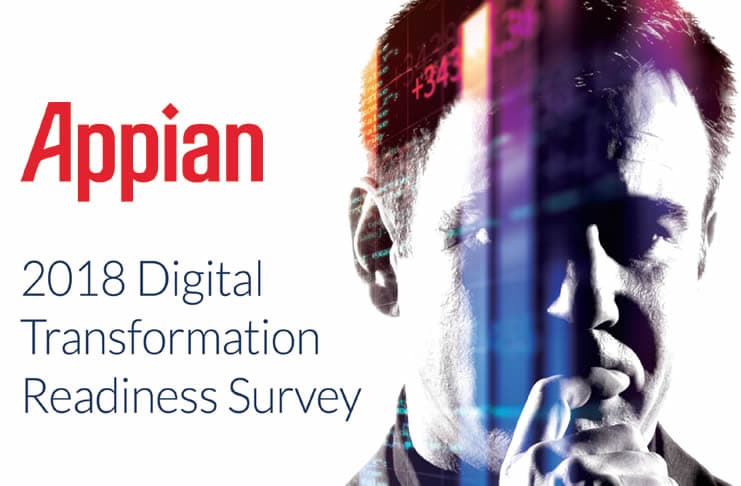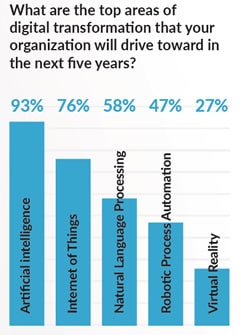Digital transformation ranks high on the executive agenda in 2018 again, including that of the multinational CEO. Yet, despite optimism concerning the state and future of digital transformation significant challenges remain as the Appian 2018 digital transformation readiness survey found.
Previously we covered some more ‘integrated’ digital transformation 2018 considerations and looked at the shifting patterns and uncertainties regarding digital transformation for 2018 from an IT industry and technology perspective.
Taking into account that digital transformation is not just about technologies nor IT both of course play a key role and this is certainly the case with application development in a DX reality where software is eating the world and companies are urged to consider themselves as software companies. Yet, that is easier said than done.

Technological priorities through 2022 according to the Appian 2018 digital transformation readiness research
On the level of technological areas the Appian 2018 digital transformation readiness research, conducted by Devops.com, found that the main areas of digital transformation that organizations aim to drive toward in the next 5 years (throughout 2022) are:

- Artificial intelligence and machine learning (93 percent of respondents)
- The IoT or Internet of Things with 76 percent of respondents
- Natural language processing with 58 percent of surveyed IT and executive leaders.
The top 5 is further completed with Robotic Process Automation (RPA) with 47 percent and Virtual Reality (27 percent).
It’s important not to see these sets of technologies and their various use cases as planned in the next five years in isolation. AI and machine learning are essential in the further development of scalable IoT projects for several reasons. Augmented reality and virtual reality need IoT, AI and natural language processing, the combinations are endless.
Keeping up with business demands in the scope of digital transformation
As we wrote before AI and IoT simply are natural partners and with, among others, advancements in AI, the increasing move to the edge (with edge computing and fog computing) and the growing amount of IoT data to turn into actionable information, insights and decisions this is only poised to grow.
In a context of the growing importance of the human-machine interface as we see it in the digital transformation of industries such as logistics, smart manufacturing and Industry 4.0 overall (including the growing usage of cobots and digital twin models to name a few), natural language processing is the conversational bridge in the cyber-physical context of Industrial IoT – and beyond.
So, ambitious digital transformation plans and goals – and not just on a technology level as the report shows – but what about the reality and the ability of overloaded IT teams to respond to these goals, digital transformation and business demands in reality?
82% of organizations can’t attract and retain the quality & quantity of software engineers required (Appian Digital Transformation Readiness Survey PR)
Reminding the fact that IT is not seen as a cost center and simply keeping IT infrastructure running doesn’t cut it anymore in times where the role of the CIO in digital transformation has been and is evolving, the Appian 2018 digital transformation readiness survey found that only little over half (54 percent) of respondents are confident that their current application portfolio provides sufficient means to build the applications which enable an optimal customer experience with the customer experience still being the main ultimate digital transformation driver.
The matter of the fact is that for most organizations it’s hard to keep up with growing demands and on the level of software delivery there is an important application backlog.
Over 60 percent of respondents have more than 10 new applications or feature requests waiting and in many cases that number even rises to 50 or more.
Digital transformation readiness: the technical debt challenge
In other words: there is already so much to do today – and yesterday – that the backlog for ongoing progress in the development of applications and features needed for digital transformation.
Despite optimism about digitizing enterprise environments, organizations face significant challenges in meeting business demand, achieving competitive differentiation, and driving innovation
It’s certainly true that CIOs and IT teams face huge pressure in focusing on the core business and on innovation instead of keeping the lights on as once was the case. Add to that the problems of legacy applications they have to deal with, in some cases additional work in the scope of changing regulatory requirements (you do need resources to tackle the requirements of compliance with new far-reaching regulations of which the GDPR or General Data Protection Regulation is just one), a lack of resources overall (including budgets and talent), the different languages that LOB executives speak in terms of what they want from a business perspective and that of IT leaders in translating it all into technical logic (not to mention the ongoing integration of IT and OT teams in many areas where different languages are spoken too) and the picture becomes clear.
Although the intentions regarding digital transformation and combining several technologies to realize value and enhance the customer experience are there, de facto organizations struggle to make it happen.
“Technical debt” is the key reason why there are delays in turning business requirements into the needed applications. It is partially about some of the just mentioned challenges but there is more as you can read in the Appian 2018 digital transformation readiness survey report.
It’s in solving that technical debt that Appian plays a role with its low-code solutions that enable faster application development by using a modular building block approach with pre-coded components and far shorter development cycles.
More in the press release of the Appian 2018 digital transformation readiness research where we also got the data and mentioned quotes and of course you can also check the full Appian 2018 digital transformation readiness survey report which contains far more findings and advice and definitely is a digital transformation wake-up call, indicating the gaps between what business wants and what is effectively possible in several organizations.
All images and logos are courtesy and ownership of their respective mentioned owners.

